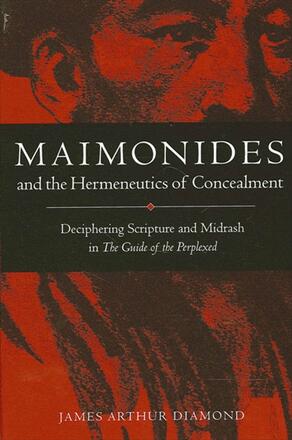
Maimonides and the Hermeneutics of Concealment
Deciphering Scripture and Midrash in The Guide of the Perplexed
Alternative formats available from:
Examines how Maimonides integrates scriptural and rabbinic literature into his magnum opus, The Guide of the Perplexed.
Description
Winner of the 2003 Nachman Sokol-Mollie Halberstadt Prize in Biblical/Rabbinic Scholarship presented by the Canadian Jewish Book Awards
Maimonides and the Hermeneutics of Concealment demonstrates the type of hermeneutic that the medieval Jewish philosopher Moses Maimonides (1138–1204) engaged in throughout his treatise, The Guide of the Perplexed. By comprehensively analyzing Maimonides' use of rabbinic and scriptural sources, James Arthur Diamond argues that, far from being merely prooftexts, they are in fact essential components of Maimonides' esoteric stratagem. Diamond's close reading of biblical and rabbinic citations in the Guide not only penetrates its multilayered structure to arrive at its core meaning, but also distinguishes Maimonides as a singular contributor to the Jewish exegetical tradition.
James Arthur Diamond is Joseph and Wolf Lebovic Chair of Jewish Studies at the University of Waterloo.
Reviews
"Diamond's book allows us to appreciate Maimonides' exegetical genius as has not been demonstrated before. " — SPECULUM
"James Diamond's lucid and interesting study of The Guide of the Perplexed takes seriously Maimonides' own claim that his book was written 'to explain the meanings of certain terms occurring in the books of prophecy' and in order to explain 'very obscure parables occurring in the books of the prophets. ' These fundamental aspects of the Guide have not yet been given their due in scholarly literature, and it is to Diamond's great credit that he takes Maimonides seriously on this issue, and in so penetrating a manner. All students of Maimonides are in his debt. " — Menachem Kellner, author of Maimonides on the Decline of the Generations and the Nature of Rabbinic Authority
"After taking the methodological lesson of Diamond's book to heart, conscientious readers won't be able to read the Guide in quite the same way as they did before—without following the trails of the prooftexts more consistently and thoroughly all the way to their destinations. " — Josef Stern, author of Problems and Parables of Law: Maimonides and Nahmanides on Reasons for the Commandments (Ta'amei Ha-Mitzvot)
"There are many books about what Maimonides said, but far fewer books about how he said it. James A. Diamond's important new book brings the method of Maimonides as a philosophical exegete of Scripture to contemporary discussions of hermeneutics. Diamond's achievement is to make Maimonides a renewed participant in the type of discussion where philosophy is always the explication of an older text. Diamond shows very well how Maimonides is just too important to be left to antiquarian interest alone. " — David Novak, University of Toronto